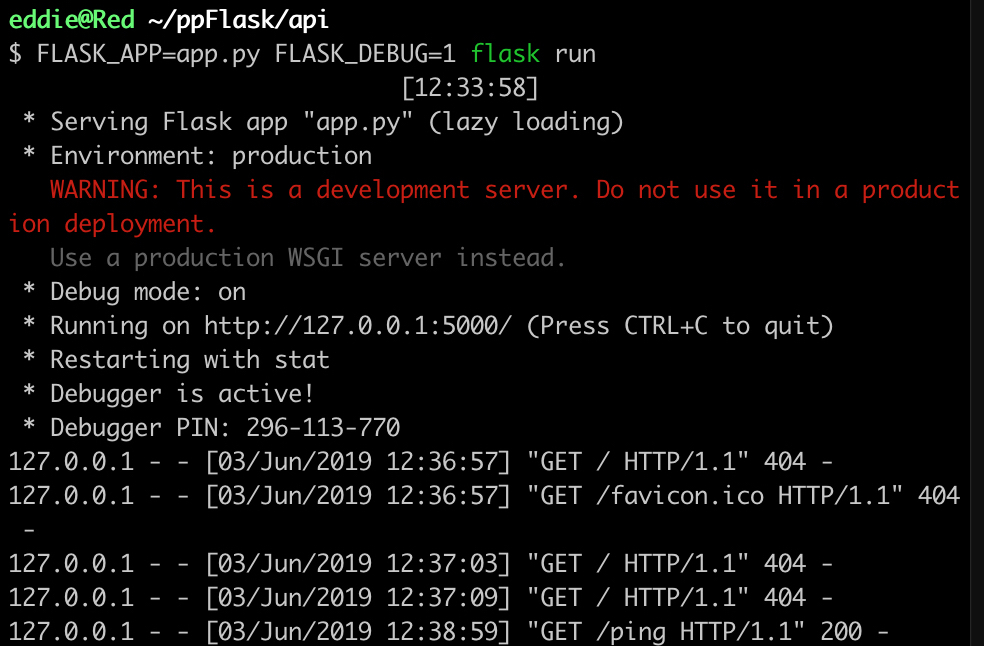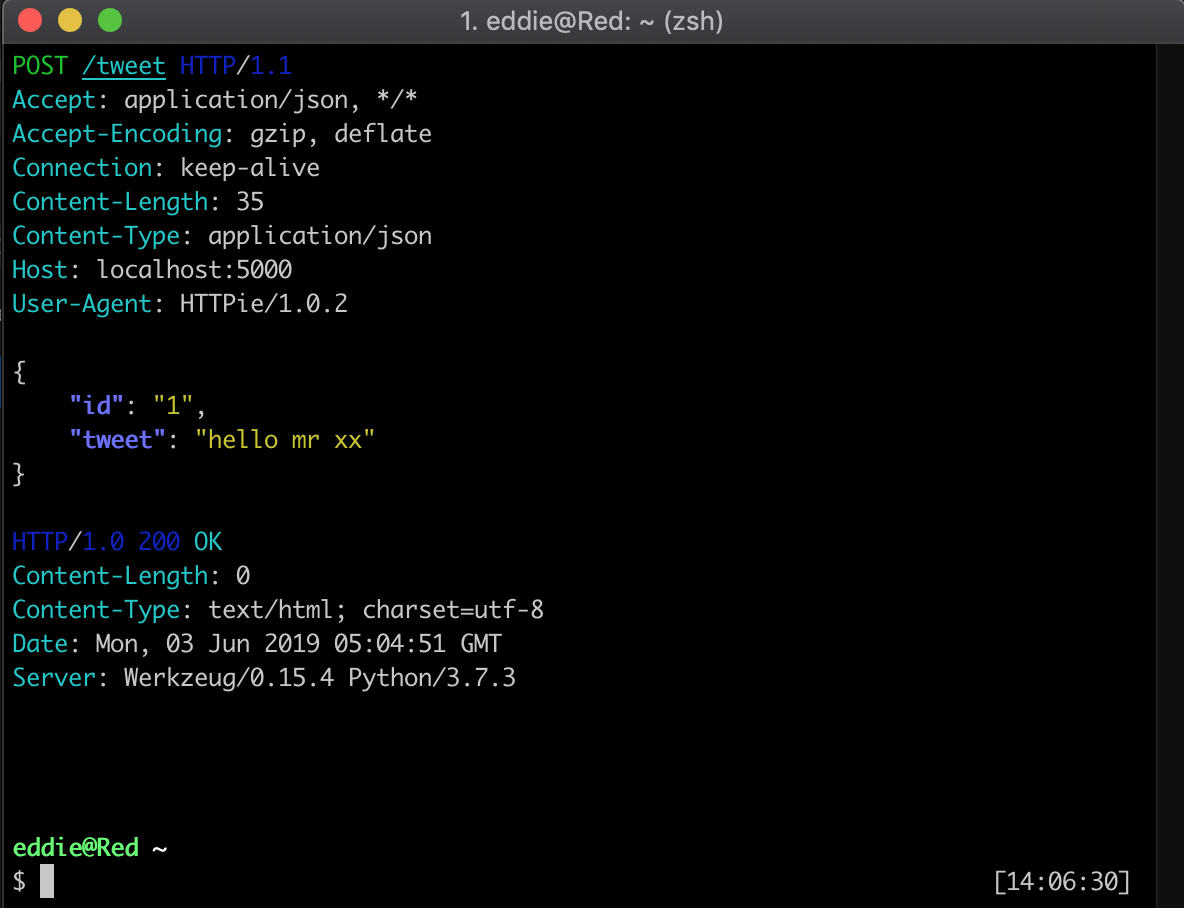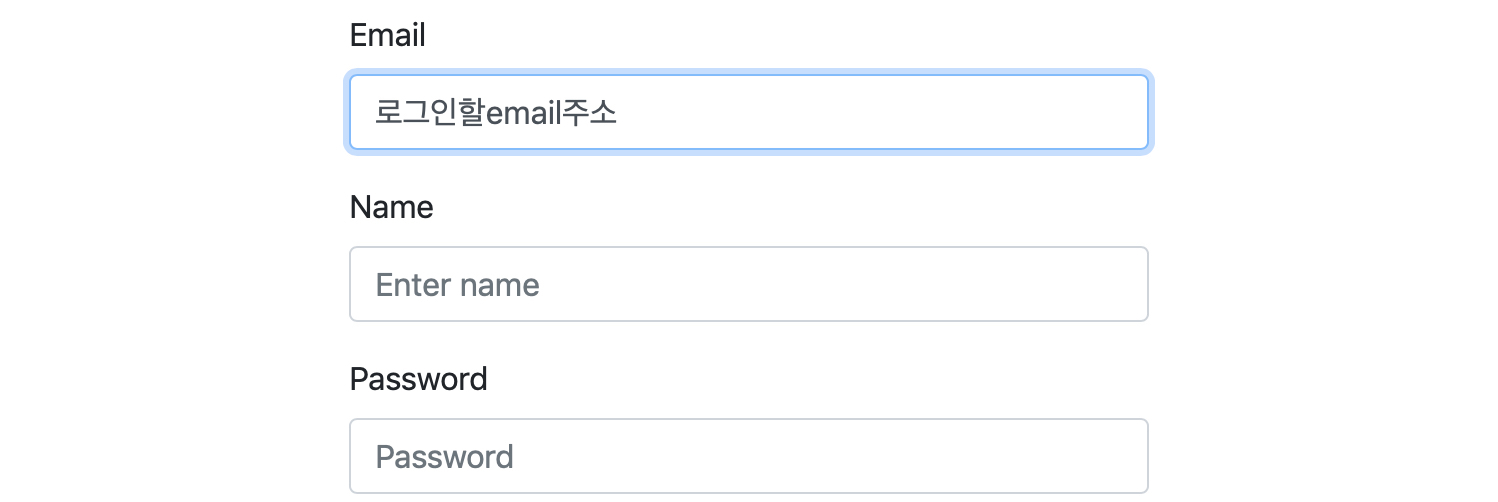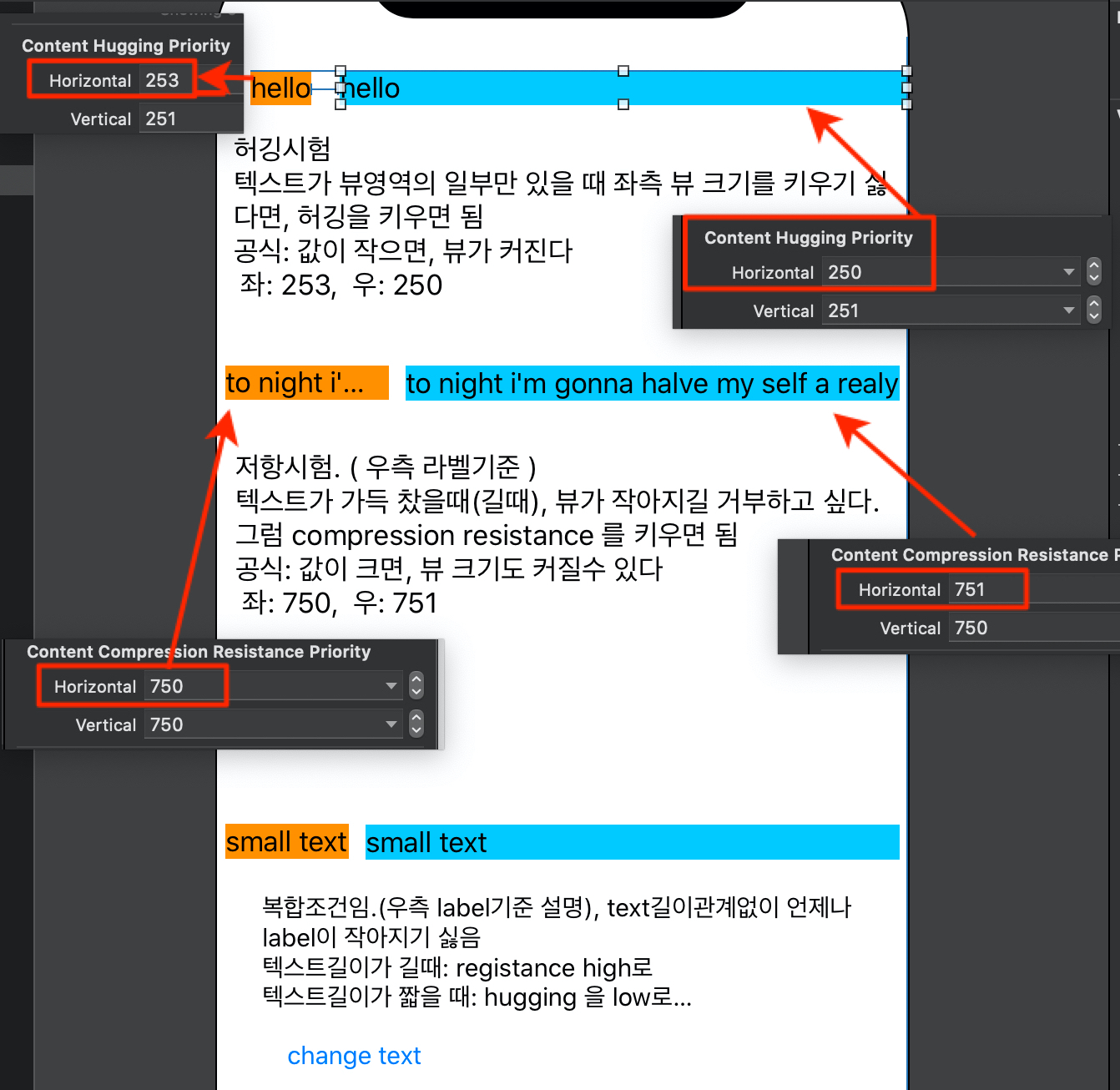Making Simple Server
ping 서버부터 만들기.
출처: 어떤 flask책인데 제목(백엔드어쩌고)을 까먹었네요. 나중에 업데이트하죠.ㅜㅜ
ping을 보내면 pong이라고 대답하는 서버를 만들고자 한다. flask를 사용할 것이다.
가장 기본적인 Ping서버 만드는 코드는 다음과 같다.
from flask import Flask
app = Flask(__name__)
@app.route("/ping", methods = ['GET'])
def ping():
return "pong"
터미널에서 아래처럼 입력하면 ping 서버가 응답합니다.
$ http -v GET http://localhost:5000/ping
핑을 보낸화면

응답화면

회원가입 기능 추가한 코드
from flask import Flask, jsonify, request
app = Flask(__name__)
app.users = {}
app.id_count = 1 #새 사용자가 회원가입할 때마다 증가
@app.route("/ping", methods = ['GET'])
def ping():
return "pong"
@app.route("/sign-up", methods=['POST']) #포스트 임을 주의
def sign_up():
new_user = request.json
# request는 endpoint에 전송된 해당 HTTP요청을 통해 전송된 json데이터를 파이썬 딕셔너리로 변환해준다.
new_user["id"] = app.id_count
app.users[app.id_count] = new_user # 딕셔너리에 사용자 정보를 저장해줌
app.id_count = app.id_count + 1 #
return jsonify(new_user) # dictionary를 json으로 변환해줌.
이번에는 트위터 내용을 보내는 기능을 추가한다
기존 소스에 아래 내용만 덧붙인다
# 트윗 저장소를 만듬 ------------------------------------
app.tweets = []
@app.route("/tweet", methods=['POST'])
def tweet():
payload = request.json
user_id = int(payload['id'])
tweet_content = payload['tweet']
if user_id not in app.users:
return "그런 사용자가 존재하지 않네요", 400
if len(tweet_content) > 300:
return "300자 초과했어요", 400
user_id = int(payload['id'])
app.tweets.append({
'user_id': user_id,
'tweet' : tweet
})
return '', 200
실행

이때 주의할 점은 가입절차부터 다시 해야 한다는 것이다. 서버가 다시 실행되면서 기존 id=1인 사용자가 지워졌기 때문이다.
이제 follow 기능추가
follow기능을 추가하려면 아래 처럼 작성한다
@app.route("/follow", methods=['POST'])
def follow():
payload=request.json
user_id = int(payload['id'])
user_toFollow = int(payload['id_follow'])
if user_id not in app.users:
return "그런 사용자 없습니다", 400
if user_toFollow not in app.users:
return "그런 사용자 없습니다", 400
login_user = app.users[user_id] # 기존 사용자 데이터를 읽어 들임.
login_user.setdefault('follow',set()).add(user_toFollow)
return jsonify(login_user)
실행하니 아래 처럼 에러가 발생한다. Set 타입을 적절하게 처리하지 못하기 때문임.
.
.
return _json.JSONEncoder.default(self, o)
File "/Users/eddie/miniconda3/envs/api/lib/python3.7/json/encoder.py", line 179, in default
raise TypeError(f'Object of type {o.__class__.__name__} '
TypeError: Object of type set is not JSON serializable
-->
아래 코드를 추가한후 재 실행하자
from flask.json import JSONEncoder
class CustomJSONEncoder(JSONEncoder):
def default(self, obj): #default method를 over write 함.
if isinstance(obj, set): #set타입이라면 list로 변환한다.
return list(obj)
return JSONEncoder.default(self, obj)
app.json_encoder = CustomJSONEncoder
타임라인 추가
아래 코드를 보자.
특히 여기서는 <int:user_id>라는 명령어가 보임. “Timeline/1” 일 때 user_id에 1이 int 값으로 들어가는 것임. 이것을 def timeline(user_id) 함수의 user_id에서 사용하게 된다.
전체코드는 다음과 같다. 단 timeline에 에러가 있음.ㅜㅜ.
from flask import Flask, jsonify, request
app = Flask(__name__)
app.users = {}
app.id_count = 1 #새 사용자가 회원가입할 때마다 증가
@app.route("/ping", methods = ['GET'])
def ping():
return "pong"
# 회원 가입 데코레이터 부분 ------------------------------------
@app.route("/sign-up", methods=['POST']) #포스트 임을 주의
def sign_up():
new_user = request.json # request는 endpoint에 전송된 해당 HTTP요청을 통해 전송된 json데이터를 파이썬 딕셔너리로 변환해준다.
new_user["id"] = app.id_count
app.users[app.id_count] = new_user # 딕셔너리에 사용자 정보를 저장해줌
app.id_count = app.id_count + 1 #
return jsonify(new_user) # dictionary를 json으로 변환해줌.
# 트윗 저장소를 만듬 ------------------------------------
app.tweets = []
@app.route("/tweet", methods=['POST'])
def tweet():
payload = request.json
user_id = int(payload['id'])
tweet_content = payload['tweet']
if user_id not in app.users:
return "그런 사용자가 존재하지 않네요", 400
if len(tweet_content) > 300:
return "300자 초과했어요", 400
user_id = int(payload['id'])
app.tweets.append({
'user_id': user_id,
'tweet' : tweet
})
return '', 200
# follow 하는 함수 추가 ------------------------------------
@app.route("/follow", methods=['POST'])
def follow():
payload=request.json
user_id = int(payload['id'])
user_toFollow = int(payload['id_follow'])
if user_id not in app.users:
return "그런 사용자 없습니다", 400
if user_toFollow not in app.users:
return "그런 사용자 없습니다", 400
login_user = app.users[user_id] # 기존 사용자 데이터를 읽어 들임.
login_user.setdefault('follow',set()).add(user_toFollow)
return jsonify(login_user)
from flask.json import JSONEncoder
class CustomJSONEncoder(JSONEncoder):
def default(self, obj): #default method를 over write 함.
if isinstance(obj, set): #set타입이라면 list로 변환한다.
return list(obj)
return JSONEncoder.default(self, obj)
app.json_encoder = CustomJSONEncoder
# unfollow 하는 함수 추가 ------------------------------------
@app.route("/unfollow", methods=['POST'])
def unfollow():
payload=request.json
user_id = int(payload['id'])
user_toUnfollow = int(payload['id_follow'])
if user_id not in app.users:
return "그런 사용자 없습니다", 400
if user_toUnfollow not in app.users:
return "그런 사용자 없습니다", 400
login_user = app.users[user_id] # 기존 사용자 데이터를 읽어 들임.
login_user.setdefault('follow',set()).discard(user_toFollow)
return jsonify(login_user)
# timeline 함수 추가 ------------------------------------
@app.route('/timeline/<int:user_id>',methods = ['GET'])
def timeline(user_id):
if user_id not in app.users:
return "그런 사용자 없습니다", 400
follow_list = app.users[user_id].get('follow',set())
follow_list.add(user_id)
timeline = [tweet for tweet in app.tweets if tweet['user_id'] in follow_list]
return jsonify({
'user_id': user_id,
'timeline': timeline
})
mysql installation
설치는 다 했는데 아래 과정에서 에러가 발생할수 있다.
$ mysql_secure_installation [16:54:35]
Securing the MySQL server deployment.
Enter password for user root:
Error: Can't connect to local MySQL server through socket '/tmp/mysql.sock' (2)
이는 다음 코드로써 해결가능하다
sudo mkdir /var/mysql
sudo ln -s /tmp/mysql.sock /var/mysql/mysql.sock
이후 다시 터미널에서 비밀번호를 설정하자
$ mysql_secure_installation
참고 사이트: https://ssumer.com/qa-맥북-mysql-구동이-안되요/
이제 mysql -u root -p명령어를 실행해보자.
$ mysql -u root -p [17:17:12]
Enter password:
Welcome to the MySQL monitor. Commands end with ; or \g.
Your MySQL connection id is 12
Server version: 8.0.16 Homebrew
Copyright (c) 2000, 2019, Oracle and/or its affiliates. All rights reserved.
Oracle is a registered trademark of Oracle Corporation and/or its
affiliates. Other names may be trademarks of their respective
owners.
Type 'help;' or '\h' for help. Type '\c' to clear the current input statement.
mysql>
이제 추가로 필요한 아래 패키지를 각각 설치하자
$ pip install sqlalchemy
$ pip install mysql-connector-python
config.py
아래 코드를 저장하자.
db = {
'user':'root',
'password':'test1234',
'host': 'localhost',
'port': 3306,
'database': 'miniter'
}
DB_URL = f"mysql+mysqlconnector://{db['user']}:{db['password']}@{db['host']}:{db['port']}/{db['database']}?charset=utf8"
app.py수정
아래 처럼 수정한다.
from flask import Flask, jsonify, request
from sqlalchemy import create_engine, text #추가한부분.
def create_app(test_config = None):
app = Flask(__name__)
if test_config is None:
app.config.from_pyfile("config.py") #unittest 하는 경우가 아니라면 config.py를 읽는다.
else:
app.config.update(test_config)
database = create_engine(app.config['DB_URL'], encoding = 'utf-8', max_overflow = 0) #sqlAlchemy사용하는 부분임.
app.database = database #생성한 Engine 객체를 플라스크 객체에 저장함. 이로써 현재 .py파일에서 데이터 베이스 접근이 가능함.
return app
회원가입을 Database로 하기
app소스 - 우선 돌아가는것만 확인했음.
전체 소스중에 필요 부분만 남기고 삭제필요함.
from flask import Flask, jsonify, request, current_app
from flask.json import JSONEncoder
from sqlalchemy import create_engine, text
class CustomJSONEncoder(JSONEncoder):
def default(self, obj): #default method를 over write 함.
if isinstance(obj, set): #set타입이라면 list로 변환한다.
return list(obj)
return JSONEncoder.default(self, obj)
#app.json_encoder = CustomJSONEncoder
def create_app(test_config = None): #flask가 자동으로 이 함수를 인식함. 또한 test_config라는 인자를 받아 유닛테스트때 사용.
app = Flask(__name__)
app.json_encoder = CustomJSONEncoder
if test_config is None:
app.config.from_pyfile("config.py") #unittest 하는 경우가 아니라면 config.py를 읽는다.
else:
app.config.update(test_config)
database = create_engine(app.config['DB_URL'], encoding = 'utf-8', max_overflow = 0) #sqlAlchemy사용하는 부분임.
app.database = database #생성한 Engine 객체를 플라스크 객체에 저장함. 이로써 현재 .py파일에서 데이터 베이스 접근이 가능함.
return app
app = create_app()
@app.route("/ping", methods = ['GET'])
def ping():
return "pong"
# 회원 가입 데코레이터 부분 ------------------------------------
@app.route("/sign-up", methods=['POST']) #포스트 임을 주의
def sign_up():
new_user = request.json # request는 endpoint에 전송된 해당 HTTP요청을 통해 전송된 json데이터를 파이썬 딕셔너리로 변환해준다.
new_user_id = app.database.execute(text("""
INSERT INTO users(
name,
email,
profile,
hashed_password
) VALUES(
:name,
:email,
:profile,
:password
)
"""), new_user).lastrowid
row = current_app.database.execute(text("""
SELECT
id,
name,
email,
profile
FROM users
WHERE id = :user_id
"""),{
'user_id': new_user_id
}).fetchone()
created_user = {
'id' : row['id'],
'name' : row['name'],
'email' : row['email'],
'profile' : row['profile']
} if row else None
return jsonify(created_user) # dictionary를 json으로 변환해줌.
가입을 해 본다
$ http -v POST http://localhost:5000/sign-up name=hallo email=halloX@gmail.com password=test1234 profile="Halo test profile"
다음은 tweet을 날려보는 함수를 database를 사용하도록 수정해본다
# 트윗 저장소를 만듬 ------------------------------------
@app.route("/tweet", methods=['POST'])
def tweet():
user_tweet = request.json
tweet_content = user_tweet['tweet']
if len(tweet_content) > 300:
return "300자 초과했어요", 400
app.database.execute(text("""
INSERT INTO tweets(
user_id,
tweet
) VALUES(
:id,
:tweet
)
"""), user_tweet)
return '', 200
셸에 다음과 같이 트윗을 날려본다
$ http -v POST http://localhost:5000/tweet id=2 tweet="hello tweet world again with number2"
타임라인을 추가한다.
# Timeline 을 보여줌 ------------------------------------
@app.route('/timeline/<int:user_id>',methods = ['GET'])
def timeline(user_id):
rows = app.database.execute(text("""
SELECT
t.user_id,
t.tweet
FROM tweets t
LEFT JOIN users_follow_list ufl ON ufl.user_id = :user_id
WHERE t.user_id = :user_id
OR t.user_id = ufl.follow_user_id
"""), {
'user_id' : user_id
}).fetchall()
timeline = [{
'user_id': row['user_id'],
'timeline': row['tweet']
} for row in rows]
return jsonify({
'user_id': user_id,
'timeline': timeline
})
이번 명령어는 get이다.
$ http -v GET http://localhost:5000/timeline/1
결과
HTTP/1.0 200 OK
Content-Length: 191
Content-Type: application/json
Date: Tue, 04 Jun 2019 09:19:39 GMT
Server: Werkzeug/0.15.4 Python/3.7.3
{
"timeline": [
{
"timeline": "hello tweet world",
"user_id": 1
},
{
"timeline": "hello tweet world again",
"user_id": 1
}
],
"user_id": 1
}
또 http -v GET http://localhost:5000/timeline/2의 결과는 다음과 같다.
$ http -v GET http://localhost:5000/timeline/2 [9:11:23]
GET /timeline/2 HTTP/1.1
Accept: */*
Accept-Encoding: gzip, deflate
Connection: keep-alive
Host: localhost:5000
User-Agent: HTTPie/1.0.2
HTTP/1.0 200 OK
Content-Length: 131
Content-Type: application/json
Date: Wed, 05 Jun 2019 00:11:36 GMT
Server: Werkzeug/0.15.4 Python/3.7.3
{
"timeline": [
{
"timeline": "hello tweet world again with number2",
"user_id": 2
}
],
"user_id": 2
}
현재까지의 전체 코드를 한번 보자.
from flask import Flask, jsonify, request, current_app
from flask.json import JSONEncoder
from sqlalchemy import create_engine, text
class CustomJSONEncoder(JSONEncoder):
def default(self, obj): #default method를 over write 함.
if isinstance(obj, set): #set타입이라면 list로 변환한다.
return list(obj)
return JSONEncoder.default(self, obj)
def create_app(test_config = None): #flask가 자동으로 이 함수를 인식함. 또한 test_config라는 인자를 받아 유닛테스트때 사용.
app = Flask(__name__)
app.json_encoder = CustomJSONEncoder
if test_config is None:
app.config.from_pyfile("config.py") #unittest 하는 경우가 아니라면 config.py를 읽는다.
else:
app.config.update(test_config)
database = create_engine(app.config['DB_URL'], encoding = 'utf-8', max_overflow = 0) #sqlAlchemy사용하는 부분임.
app.database = database #생성한 Engine 객체를 플라스크 객체에 저장함. 이로써 현재 .py파일에서 데이터 베이스 접근이 가능함.
# 모든 데코레이터 & 함수들은 create_app 내부에 정의함 ( 이하 )
@app.route("/ping", methods = ['GET'])
def ping():
return "pong"
# 회원 가입 데코레이터 부분 ------------------------------------
@app.route("/sign-up", methods=['POST']) #포스트 임을 주의
def sign_up():
new_user = request.json # request는 endpoint에 전송된 해당 HTTP요청을 통해 전송된 json데이터를 파이썬 딕셔너리로 변환해준다.
new_user_id = app.database.execute(text("""
INSERT INTO users(
name,
email,
profile,
hashed_password
) VALUES(
:name,
:email,
:profile,
:password
)
"""), new_user).lastrowid
row = current_app.database.execute(text("""
SELECT
id,
name,
email,
profile
FROM users
WHERE id = :user_id
"""),{
'user_id': new_user_id
}).fetchone()
created_user = {
'id' : row['id'],
'name' : row['name'],
'email' : row['email'],
'profile' : row['profile']
} if row else None
return jsonify(created_user) # dictionary를 json으로 변환해줌.
# 트윗 저장소를 만듬 ------------------------------------
@app.route("/tweet", methods=['POST'])
def tweet():
user_tweet = request.json
tweet_content = user_tweet['tweet']
if len(tweet_content) > 300:
return "300자 초과했어요", 400
app.database.execute(text("""
INSERT INTO tweets(
user_id,
tweet
) VALUES(
:id,
:tweet
)
"""), user_tweet) #sql 문을 통해 insert될 트윗 데이터는 HTTP요청을 통해 전송된 JSON데이터 그대로 사용함.
return '', 200
# Timeline 을 보여줌 ------------------------------------
@app.route('/timeline/<int:user_id>',methods = ['GET'])
def timeline(user_id):
rows = app.database.execute(text("""
SELECT
t.user_id,
t.tweet
FROM tweets t
LEFT JOIN users_follow_list ufl ON ufl.user_id = :user_id
WHERE t.user_id = :user_id
OR t.user_id = ufl.follow_user_id
"""), {
'user_id' : user_id
}).fetchall()
timeline = [{
'user_id': row['user_id'],
'timeline': row['tweet']
} for row in rows]
return jsonify({
'user_id': user_id,
'timeline': timeline
})
# 명령 : http -v GET http://localhost:5000/timeline/1
return app #end of create_app
follow 와 unfollow 추가하기
기존 기능들 또 update하자.
@app.route('/follow', methods =['POST'])
def follow():
jsonContent = request.json
app.database.execute(text("""
INSERT INTO users_follow_list(
user_id,
follow_user_id
) VALUES(
:id,
:follow
)
"""), jsonContent)
return '', 200
##bcrypt
사용
$ python
>>> import bcrypt
>>> bcrypt.hashpw(b"secrete passxx", bcrypt.gensalt())
b'$2b$12$/gjzWytxjesc25v9u0zfDeipVNFB7agaxrK1ZpUvN2skKumjL6FyO'
>>> bcrypt.hashpw(b"secrete passxx", bcrypt.gensalt()).hex()
'2432622431322432433731615330655a655a535a2f5a55326b464252655451707a4e512f765632454e6c785938384364616756554f63484b51536543'
JWT
PyJWT설치후 시험
>>> import jwt
>>> data_to_encode = {'hello':'payload'} #딕셔너리형태 주의바람
>>> encryption_secret = 'secret'
>>> algo = 'HS256'#JWT의 signature부분을 암호화할 때 사용할 암호 알고리즘 지정.
>>> encoded = jwt.encode(data_to_encode, encryption_secret, algorithm=algo)
확인
b'eyJ0eXAiOiJKV1QiLCJhbGciOiJIUzI1NiJ9.eyJoZWxsbyI6InBheWxvYWQifQ.rWCdlaDThW1XjJqfPtf8SqUGZ100YatqqYgRrz2kpPE'
다시 디코딩해보면
>>> jwt.decode(encoded, encryption_secret, algorithms=[algo])
{'hello': 'payload'}
위에서 인코딩할 때 encryption_secret = 'secret'부분을 볼 수 있는데, 여기서 secret라는 문자열은 너무 단순하므로 실제 상용서비스에서는 복잡한 값을 사용하도록 한다.
회원가입 암호화
우선 이전 버전의 signup()은 아래와 같다.
def sign_up():
new_user = request.json # request는 endpoint에 전송된 해당 HTTP요청을 통해 전송된 json데이터를 파이썬 딕셔너리로 변환해준다.
new_user_id = app.database.execute(text("""
INSERT INTO users(
name,
email,
profile,
hashed_password
) VALUES(
:name,
:email,
:profile,
:password
)
"""), new_user).lastrowid
row = current_app.database.execute(text("""
SELECT
id,
name,
email,
profile
FROM users
WHERE id = :user_id
"""),{
'user_id': new_user_id
}).fetchone()
created_user = {
'id' : row['id'],
'name' : row['name'],
'email' : row['email'],
'profile' : row['profile']
} if row else None
return jsonify(created_user) # dictionary를 json으로 변환해줌.
자 잠깐 여기서 전체 소스 한번 확인하시고 특히 sign_up를 두 개의 함수로 나누었다.
from flask import Flask, jsonify, request, current_app
from flask.json import JSONEncoder
from sqlalchemy import create_engine, text
class CustomJSONEncoder(JSONEncoder):
def default(self, obj): #default method를 over write 함.
if isinstance(obj, set): #set타입이라면 list로 변환한다.
return list(obj)
return JSONEncoder.default(self, obj)
def insert_user(user):
return current_app.database.execute(text("""
INSERT INTO users(
name,
email,
profile,
hashed_password
) VALUES(
:name,
:email,
:profile,
:password
)
"""), user).lastrowid
def get_user(user_id):
user = current_app.database.execute(text("""
SELECT
id,
name,
email,
profile
FROM users
WHERE id = :user_id
"""),{
'user_id': user_id
}).fetchone()
#user_id를 사용하고
#아래에서는 user를 체크함.
return {
'id' : user['id'],
'name' : user['name'],
'email' : user['email'],
'profile' : user['profile']
} if user else None
# created_user = {
# 'id' : row['id'],
# 'name' : row['name'],
# 'email' : row['email'],
# 'profile' : row['profile']
# } if row else None
# return created_user
def create_app(test_config = None): #flask가 자동으로 이 함수를 인식함. 또한 test_config라는 인자를 받아 유닛테스트때 사용.
app = Flask(__name__)
app.json_encoder = CustomJSONEncoder
if test_config is None:
app.config.from_pyfile("config.py") #unittest 하는 경우가 아니라면 config.py를 읽는다.
else:
app.config.update(test_config)
database = create_engine(app.config['DB_URL'], encoding = 'utf-8', max_overflow = 0) #sqlAlchemy사용하는 부분임.
app.database = database #생성한 Engine 객체를 플라스크 객체에 저장함. 이로써 현재 .py파일에서 데이터 베이스 접근이 가능함.
# 모든 데코레이터 & 함수들은 create_app 내부에 정의함 ( 이하 )
@app.route("/ping", methods = ['GET'])
def ping():
return "pong"
# 회원 가입 데코레이터 부분 ------------------------------------
@app.route("/sign-up", methods=['POST']) #포스트 임을 주의
def sign_up():
new_user = request.json
new_user_id = insert_user(new_user)
new_user = get_user(new_user_id)
return jsonify(new_user)
# 트윗 저장소를 만듬 ------------------------------------
@app.route("/tweet", methods=['POST'])
def tweet():
user_tweet = request.json
tweet_content = user_tweet['tweet']
if len(tweet_content) > 300:
return "300자 초과했어요", 400
app.database.execute(text("""
INSERT INTO tweets(
user_id,
tweet
) VALUES(
:id,
:tweet
)
"""), user_tweet) #sql 문을 통해 insert될 트윗 데이터는 HTTP요청을 통해 전송된 JSON데이터 그대로 사용함.
return '', 200
# Timeline 을 보여줌 ------------------------------------
@app.route('/timeline/<int:user_id>',methods = ['GET'])
def timeline(user_id):
rows = app.database.execute(text("""
SELECT
t.user_id,
t.tweet
FROM tweets t
LEFT JOIN users_follow_list ufl ON ufl.user_id = :user_id
WHERE t.user_id = :user_id
OR t.user_id = ufl.follow_user_id
"""), {
'user_id' : user_id
}).fetchall()
timeline = [{
'user_id': row['user_id'],
'timeline': row['tweet']
} for row in rows]
return jsonify({
'user_id': user_id,
'timeline': timeline
})
# 명령 : http -v GET http://localhost:5000/timeline/1
@app.route('/follow', methods =['POST'])
def follow():
jsonContent = request.json
app.database.execute(text("""
INSERT INTO users_follow_list(
user_id,
follow_user_id
) VALUES(
:id,
:follow
)
"""), jsonContent)
return '', 200
# 명령 $ http -v POST http://localhost:5000/follow id=1 follow=2
return app #end of create_app
자 이제 정말로 signup 함수를 수정해보자. 정확히는 sign_up에서 호출하는 insert_user()를 수정한다.
def sign_up():
new_user = request.json
new_user_id = insert_user(new_user)
new_user = get_user(new_user_id)
return jsonify(new_user)
#####################################################
def insert_user(user):
new_user = user # request는 endpoint에 전송된 해당 HTTP요청을 통해 전송된 json데이터를 파이썬 딕셔너리로 변환해준다.
new_user['password'] = bcrypt.hashpw(
new_user['password'].encode('UTF-8'),
bcrypt.gensalt()
)
return current_app.database.execute(text("""
INSERT INTO users(
name,
email,
profile,
hashed_password
) VALUES(
:name,
:email,
:profile,
:password
)
"""), new_user).lastrowid
그리고나서 login함수도 추가한다.
@app.route('/login',methods=['POST'])
def login():
credential = request.json
email = credential['email']
password = credential['password']
user_credential = database.execute(text("""
SELECT
id,
hashed_password
FROM users
WHERE email = :email
"""),{'email':email}).fetchone()
if user_credential and bcrypt.checkpw(password.encode('UTF-8'),user_credential['hashed_password'].encode('UTF-8')):
user_id = user_credential['id']
payload = {
'user_id' : user_id,
'exp' : datetime.utcnow() + timedelta(seconds = 60 * 60 * 24)
}
token = jwt.encode(payload, app.config['JWT_SECRET_KEY'], 'HS256')
return jsonify({
'access_token' : token.decode('UTF-8')
})
else:
return '', 401
아 여기서 계속 아래 에러가 발생했음.
$ $ http -v POST http://localhost:5000/login email=strawbx123@gmail.com password=test1234
.
.
token = jwt.encode(payload, app.config['JWT_SECRET_KEY'], 'HS256')
KeyError: 'JWT_SECRET_KEY'
에러의 내용을 보면 JWT_SECRET_KEY가 존재하지 않는 다는 내용으로 단순하다.
config.py에 내용을 적어주면 해결된다.
db = {
.
.
}
DB_URL = f"mys.....
JWT_SECRET_KEY = 'HELLO_MY_SECRET'
다시 로그인 해보자
$ http -v POST http://localhost:5000/login email=strawbx123@gmail.com password=test1234 [16:17:59]
POST /login HTTP/1.1
Accept: application/json, */*
Accept-Encoding: gzip, deflate
Connection: keep-alive
Content-Length: 57
Content-Type: application/json
Host: localhost:5000
User-Agent: HTTPie/1.0.2
{
"email": "strawbx123@gmail.com",
"password": "test1234"
}
HTTP/1.0 200 OK
Content-Length: 148
Content-Type: application/json
Date: Wed, 05 Jun 2019 07:18:13 GMT
Server: Werkzeug/0.15.4 Python/3.7.3
{
"access_token": "eyJ0eXAiOiJKV1QiLCJhbGciOiJIUzI1NiJ9.eyJ1c2VyX2lkIjoxNiwiZXhwIjoxNTU5ODA1NDkzfQ.D8PuPcJgswTI5nQyuLlezAWPbqameZ4LhhB7KsPwtxM"
}
휴. 이번에는 성공이다.ㅜㅜ
자 여기서 잠깐 decoratorㅇㅔ 대해 배워보자.
docorator라는 것은 함수를 리턴하는 함수를 말한다. 파이썬에서는 wraps라는 것을 사용하면 된다.
#decorator example
from functools import wraps
def myDecorator(f):
@wraps(f)
def decoreatedInnerFunc(*args, **kwargs):
print("Decorated function")
return f(*args, **kwargs)
return decoreatedInnerFunc
@myDecorator
def func():
print('this is just func')
func()
##결과
# Decorated function
# this is frunc just func
인증 적용하기
인증이 필요한 함수들 위에 모두 decorator를 써주면, 각 함수들은 반드시 로그인이 되어 있어야만 작동하게 된다.
#########################################################
# Decorators
#########################################################
def login_required(f):
@wraps(f)
def decorated_function(*args, **kwargs):
access_token = request.headers.get('Authorization')
if access_token is not None:
try:
payload = jwt.decode(access_token, current_app.config['JWT_SECRET_KEY'], 'HS256')
except jwt.InvalidTokenError:
payload = None
if payload is None: return Response(status=401)
user_id = payload['user_id']
g.user_id = user_id
g.user = get_user(user_id) if user_id else None
else:
return Response(status = 401)
return f(*args, **kwargs)
return decorated_function
적용하기
각 함수에 적용하기 위해서는 아래 처럼 하면 된다.
기존코드
@app.route("/tweet", methods=['POST'])
def tweet():
user_tweet = request.json
tweet_content = user_tweet['tweet']
.
.
수정된 코드
@app.route("/tweet", methods=['POST'])
@login_required #이게 추가됨
def tweet():
user_tweet = request.json
user_tweet['id'] = g.user_id
tweet_content = user_tweet['tweet']
insert_tweet(user_tweet)
@login_required가 추가된 것을 볼 수 있다.
자 이제 무심코 아래처럼 해보면 404가 떨어짐을 볼 수 있다
$ http -v POST http://localhost:5000/tweet id=1 tweet="Oh my Helloooo is upcoming22222" [16:50:50]
POST /tweet HTTP/1.1
Accept: application/json, */*
Accept-Encoding: gzip, deflate
Connection: keep-alive
Content-Length: 54
Content-Type: application/json
Host: localhost:5000
User-Agent: HTTPie/1.0.2
{
"id": "1",
"tweet": "Oh my Helloooo is upcoming22222"
}
HTTP/1.0 401 UNAUTHORIZED
Content-Length: 0
Content-Type: text/html; charset=utf-8
Date: Wed, 05 Jun 2019 07:51:23 GMT
Server: Werkzeug/0.15.4 Python/3.7.3
자 여기서 이제
def tweet():
user_tweet = request.json
tweet_content = user_tweet['tweet']
를 아래 처럼 수정하자
로그인해서 tweet()날리는 절차를 보자
아래 순서로 해야 한다.
- 먼저 로그인함수를 실행하면 access_token이 표시된다.
$ http -v POST http://localhost:5000/login email=strawbx123@gmail.com password=test1234
.
.
{
"access_token": "eyJ0eXAiOiJKV1QiLCJhbGciOiJIUzI1NiJ9.eyJ1c2VyX2lkIjoxNiwiZXhwIjoxNTU5ODA4ODAwfQ.QmDESSwtfLmJHXfIuDBXO_sBw780r0j4oMklcv_H5hg"
}
2.AccessToken을 사용해서 tweet()를 호출해 보자. 아래 처럼 해야 잘 된다
$ http -v POST http://localhost:5000/tweet tweet="halo world" "Authorization:eyJ0eXAiOiJKV1QiLCJhbGciOiJIUzI1NiJ9.eyJ1c2VyX2lkIjoxNiwiZXhwIjoxNTU5ODA4ODAwfQ.QmDESSwtfLmJHXfIuDBXO_sBw780r0j4oMklcv_H5hg"
POST /tweet HTTP/1.1
Accept: application/json, */*
Accept-Encoding: gzip, deflate
Authorization: eyJ0eXAiOiJKV1QiLCJhbGciOiJIUzI1NiJ9.eyJ1c2VyX2lkIjoxNiwiZXhwIjoxNTU5ODA4ODAwfQ.QmDESSwtfLmJHXfIuDBXO_sBw780r0j4oMklcv_H5hg
Connection: keep-alive
Content-Length: 23
Content-Type: application/json
Host: localhost:5000
User-Agent: HTTPie/1.0.2
{
"tweet": "halo world"
}
HTTP/1.0 200 OK
Content-Length: 0
Content-Type: text/html; charset=utf-8
Date: Wed, 05 Jun 2019 08:14:33 GMT
Server: Werkzeug/0.15.4 Python/3.7.3
참고: 이때 access_token를 빠뜨리면 아래 처럼 하면 401 에러가 발생한다
$ http -v POST http://localhost:5000/tweet tweet="halo world" [17:13:20]
POST /tweet HTTP/1.1
Accept: application/json, */*
Accept-Encoding: gzip, deflate
Connection: keep-alive
Content-Length: 23
Content-Type: application/json
Host: localhost:5000
User-Agent: HTTPie/1.0.2
{
"tweet": "halo world"
}
HTTP/1.0 401 UNAUTHORIZED
Content-Length: 0
Content-Type: text/html; charset=utf-8
Date: Wed, 05 Jun 2019 08:13:26 GMT
Server: Werkzeug/0.15.4 Python/3.7.3
또한 더이상 tweet함수 호출할 때 id를 적지 않아도 된다. 이에 대한 처리는 user_tweet['id'] = g.user_id가 담당하고 있다.
# 트윗 저장소를 만듬 ------------------------------------
@app.route("/tweet", methods=['POST'])
@login_required
def tweet():
user_tweet = request.json
user_tweet['id'] = g.user_id
tweet_content = user_tweet['tweet']
if len(tweet_content) > 300:
return "300자 초과했어요", 400
insert_tweet(user_tweet)
return '', 200
로그인을 위해서 frontend코드를 사용하자.
다음 url로 접속한다. http://localhost:8000/signup.html

그러면 이후 login화면으로 이동한다.

로그인 성공한 모습

이상


 Eddie Kwon - Development log for ML, iOS
Eddie Kwon - Development log for ML, iOS







